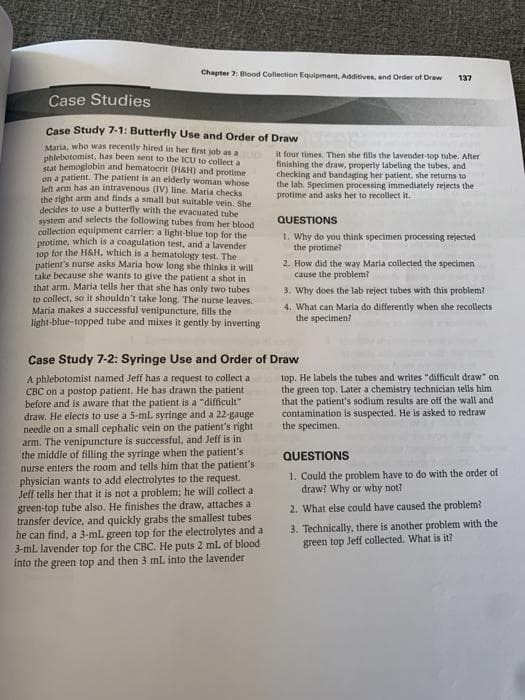1. Why do you think specimen processing rejected the protime! 2. How did the way Maria collected the specimen cause the problem? 3. Why does the lab reject tubes with this problem?
1. Why do you think specimen processing rejected the protime! 2. How did the way Maria collected the specimen cause the problem? 3. Why does the lab reject tubes with this problem?
Chapter2: Introduction To Icd-10-cm And Icd-10-pcs Coding
Section: Chapter Questions
Problem 2MC
Related questions
Question
100%

Transcribed Image Text:Chapter 7: Blood Collection Equipment, Additives, and Order of Draw
137
Case Studies
Case Study 7-1: Butterfly Use and Order of Draw
Maria, who was recently hired in her first job an a
nhlebotomist, has been sent to the ICU to collect a
stat hemoglobin and hematocrit (H&H) and protime
on a patient. The patient is an elderly woman whose
Jeft arm has an intravenous (IV) line. Maria checks
the right arm and finds a small but suitable vein, She
decides to use a butterfly with the evacuated tube
system and selects the following tubes from her blood
collecti
protime, which is a coagulation test, and a lavender
top for the H&H, which is a hematology test. The
patient's nurse asks Maria how long she thinks it will
take because she wants to give the patient a shot in
that arm. Maria tells her that she has only two tubes
to collect, so it shouldn't take long. The nurse leaves.
Maria makes a successful venipuncture, fills the
light-blue-topped tube and mixes it gently by inverting
it four times. Then she fills the lavender-top tube. After
finishing the draw, properly labeling the tubes, and
checking and bandaging her patient, she returns to
the lab. Specimen processing immediately rejects the
protime and asks her to recollecet it.
QUESTIONS
equipment carrier: a light-blue top for the
1. Why do you think specimen processing rejected
the protime?
2. How did the way Maria collected the specimen
cause the problem?
3. Why does the lab reject tubes with this problem?
4, What can Maria do differently when she recollects
the specimen?
Case Study 7-2: Syringe Use and Order of Draw
A phlebotomist named Jeff has a request to collect a
CBC on a postop patient. He has drawn the patient
before and is aware that the patient is a "difficult"
draw. He elects to use a 5-ml. syringe and a 22-gauge
needle on a small cephalic vein on the patient's right
arm. The venipuncture is successful, and Jeff is in
the middle of filling the syringe when the patient's
nurse enters the room and tells him that the patient's
physician wants to add electrolytes to the request.
Jeff tells her that it is not a problem; he will collect a
green-top tube also. He finishes the draw, attaches a
transfer device, and quickly grabs the smallest tubes
he can find, a 3-mL green top for the electrolytes and a
3-mL lavender top for the CBC. He puts 2 mL of blood
into the green top and then 3 mL into the lavender
top. He labels the tubes and writes "difficult draw" on
the green top. Later a chemistry technician tells him
that the patient's sodium results are off the wall and
contamination is suspected. He is asked to redraw
the specimen.
QUESTIONS
1. Could the problem have to do with the order of
draw? Why or why not?
2. What else could have caused the problem?
3. Technically, there is another problem with the
green top Jeff collected. What is it?
Expert Solution
This question has been solved!
Explore an expertly crafted, step-by-step solution for a thorough understanding of key concepts.
This is a popular solution!
Trending now
This is a popular solution!
Step by step
Solved in 3 steps

Knowledge Booster
Learn more about
Need a deep-dive on the concept behind this application? Look no further. Learn more about this topic, nursing and related others by exploring similar questions and additional content below.Recommended textbooks for you


Essentials Health Info Management Principles/Prac…
Health & Nutrition
ISBN:
9780357191651
Author:
Bowie
Publisher:
Cengage


Essentials Health Info Management Principles/Prac…
Health & Nutrition
ISBN:
9780357191651
Author:
Bowie
Publisher:
Cengage